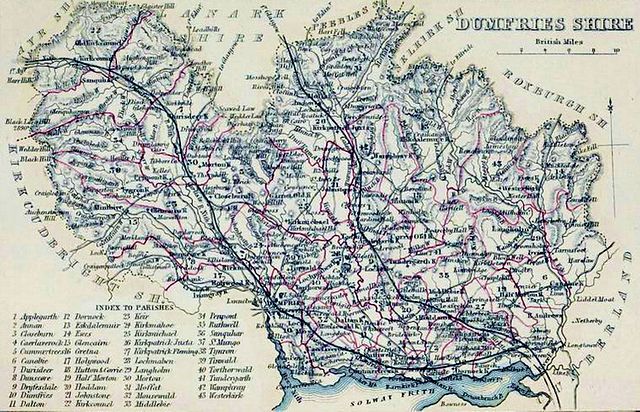Dumfriesshire

"DUMFRIESSHIRE Civil Parish map" by The Imperial gazetteer of Scotland. Vol.I. by Rev. John Marius Wilson. Licensed under Public domain via Wikimedia Commons.
This website is hosted by Graeme Hastie
Please contact me if you have any questions about Dumfriesshire.
History
The creation of a county and the establishment of a sheriffdom in Dumfriesshire were fraught with difficulties. The ancient county of Dumfries included part of Galloway as far west as the river Cree, in addition to the present area which was constituted a sheriffdom in 1 748. When in 1107 King Edgar bequeathed to his youngest brother, Prince David, Scottish Cumbria, of which the present shire of Dumfries was then a part, he granted a very disputable possession. It was a little buffer-state between two warring kingdoms. David, being both a petty king and earl (comes), had the opportunity for imposing upon his territory the feudal system, of the Anglo-Norman type, to which he had been accustomed in England. To his court he attracted Anglo-Norman and southern chivalry to support him in his rule. His regal administration was probably conducted by feudal dignitaries chancellor, constable, justiciar, chamberlain, steward, and marshal. On David's accession to the throne of Scotland in 1124, according to Gaelic custom and feudal law, his personal property became an appanage of the crown.
But at least one of the three great divisions of the border- land, namely Strathnith, was still ruled by a Celtic over-lord Dunegal; and, in like manner, probably Annan- dale and Eskdale were governed by hereditary chiefs. David found it impolitic at once to discard the old code of law and customs, which, as in the case of Galloway, prevailed in some measure for centuries. The eastern boundary of Gaway or Galloway is not easily determined now. Consequently the Celtic over-lord of Strathnith (Nithsdale, and probably part of Galloway) was left undisturbed. Annandale, however a tract stretching to the Forest of Selkirk was granted to Robert de Brus, while the constable, Morville, got Cunningham, and the steward, FitzAlan, got Renfrew and part of Kyle. To prevent jealousies among the local chiefs the Brus was not created an earl. If Dunegal held the office of a Maor (who corresponded to the Gerefa or sheriff of the Saxons) on his own land, he might act as a vice-comes. The early kings themselves, in their progresses with their justiciars, presided over the courts of law. It is natural to expect, therefore, that the castle-guard of the county was connected with the territory governed by Dunegal. The county (comitatus) for seven centuries has been associated with the town of Dumfries a place where Dunegal and Radnulf his son held and disponed heritage about the middle of the twelfth century. Radnulf 's charter was given at "Dronfres," which in the Gaelic tongue signifies "the ridge of the bushes" (phreas). This corresponds with the persistent local pronunciation "Drumfreesh." The next form of the word is Dunfres and Dunfrez (1183-8), a significant change after the dun or fort of Dunegal, on the bushy ridge, became of paramount importance. This form of the word, "Dunfrys," appears in 1296, and "Drumfres" holds on in charters after 1329. What in the way of establishing feudalism David and Malcolm left undone William the Lyon completed. About the year 1186 he erected a strong castle (castrum) at Dunfres to overawe the rebellious Galwegians. In that military centre the officers of the king held their courts, and received the service and fees of the knights and barons of the district as well as customs due to the Crown. Annandale was exempted from castle- ward. Guarded by the castle, the new royal burgh of Dumfries thus early rose, and from it the sheriff made the lieges keep the king's peace. The boundaries of this sheriffdom (vice-comitatus) in course of time were curtailed. The sheriff's jurisdiction, however, was not, in all matters, commensurate with the boundaries of the county. Annandale had the separate jurisdiction of a stewartry, Eskdale that of a regality. Till the middle of the eighteenth century, sheriffdom, stewartry, and regality were hereditary in different noble families in succession. When the Scotts of Buccleuch held the regality, they got their Eskdale lands transferred to the sheriffdom of Roxburgh, from which they were separated in 1748 and joined again to Dumfries. The burgh of Dumfries was in the fifteenth century excluded from the sheriff's jurisdiction in respect of "actions of blood" a privilege confirmed to the town by James IV in 1509.
The county became adjusted to its modern conditions when parliament, by the "Heretable Jurisdictions " Act, 1747, abolished heritable jurisdictions. The Duke of Queensberry, hereditary sheriff of Dumfries and coroner of Nithsdale, received £6621. 8s. 5d. in compensation for his loss of offices; the Marquis of Annandale, 3000 for the loss of the stewardship of Annandale, and the regality of Moffat; and the Duke of Buccleuch £1400 for the regality of Eskdale.
Hewison, James. Dumbriesshire. Cambridge: University Press, 1912.
Queries and Surnames
Submit and View Queries and Surnames Submit a Query or Surnames for your lost Dumfriesshire Scotland ancestor. Please use the linking feature only for genealogical material otherwise your query may be deleted.
{all_weblinks}60{/all_weblinks}
